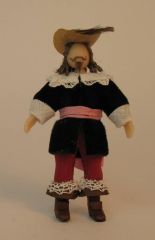Fashion is by no means a recent invention. E.g., Medieval paintings show that people largely followed the same fashion dictates all over Western Europe at that time, and researchers have found that new fashions spread pretty quickly.
So, even though I've used the English terms for the different eras, the clothes shown on this page represent what fashionable people may have worn not only in England but also in France, Germany, Sweden, and other parts of Europe.
How the dolls are made
All my female dolls with floor-lenght skirts have a solid base from the waist down, not legs. I think this approach has several advantages - I don't have to make shoes, they can stand without support, and the base helps giving the skirt the correct shape. The method I use for creating a female doll's body was described in LEN volume 3, issue 3. Then I proceed to dress them using cotton or silk fabrics.
Medieval
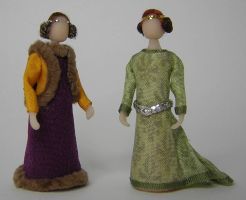
These ladies date to around 1350. Their hair is held in a crispinette (hair net) with a fillet (narrow headband) above. Both wear a cotehardie (dress), and on top of it one of them wears a sideless surcoat edged with fur. All fabrics are silk, and the fur edge is trimmed down chenille yarn. I used the miniature dress patterns compiled by Pam Scott for the LEN online group.
Tudor
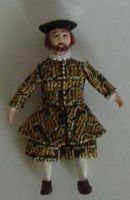
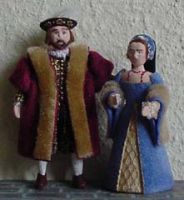
A wealthy couple in the days of king Henry VIII, circa 1535. They live in the castle. The man wears silk breeches (with leather codpiece), doublet (=jacket) and jerkin (=vest) under his "velvet" gown with "fur" collar (the gown is not removable - I took the 2nd photo before adding the gown). His baret is trimmed with feathers and "jewels". The lace edges of his shirt show around his neck and wrists (I used unraveled bunka to simulate a lace frill). His wife wears a "velvet" gown with "fur"-trimmed sleeves. A decorative petticoat with a gold pattern shows in front, and her undersleeves are made from the same fabric (I used a fabric with a raised design, which I decorated with gold paint). Most of her hair is covered by the french hood (made from the same fabric as her dress) and its black silk veil.
The man's clothes are based on 1:12 scale patterns and instructions in The Dolls' House Magazine issue 48 (May 2002). For his wife, I started with Holbein's 1536 portrait of Jane Seymour (the 3rd wife of king Henry VIII), and then researched similar styles using various books as well as Tudor reenactment websites.
Tudor maid
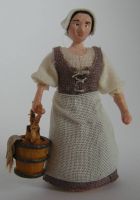
The couple above has a maid to do the work around the house, so they don't risk spoiling their fine clothes.
I based the maid's clothes closely on 1:12 scale patterns and instructions for a "Tudor serving wench" in The Dolls' House Magazine issue 76 (September 2004). The main change I made was to skip the cleavage! I dyed the fabrics myself, using silk paint (mix a few drops of the right color, soak a small bit of fabric and let it dry, set with an iron).
Cavalier gentleman
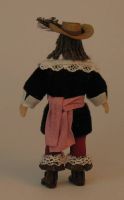
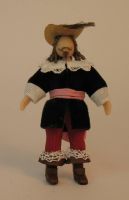
The extravagant clothes of this guy dates to around 1640 - contemporary with The Three Musketeers in Alexandre Dumas' books. I based his clothes closely on a how-to from Shellie's Free Projects, a wonderful site that unfortunately no longer exists. Shellie was a pioneer in providing free how-to projects on the web; I first saw her site way back in 1996 (if not even earlier).
Georgian
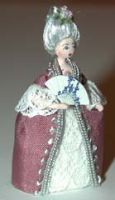
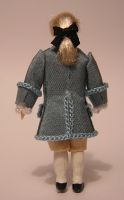
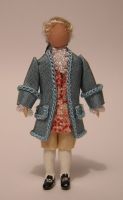
This couple represents the fashions of the middle of the 18th century. The gentleman wears a colorful waistcoat under his coat, and his long hair is tied with a black silk bow. I used unravelled bunka to simulate lace frill in his jabot and cuffs. The stockings, shoes, and buckles are painted on. (Click for closeups of the gentleman.)
Regency
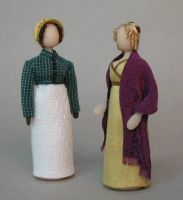
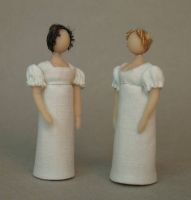
I love BBC:s adaption of Jane Austen's Pride and Prejudice, set early in the 19th century. Here I've dressed the two eldest Miss Bennets - in the first pic they're wearing the typical light colored dresses of the era, in the second Elizabeth returns from a walk wearing a spencer (short jacket) and bonnet, and Jane is dressed up for a party.
Early Victorian ballgown
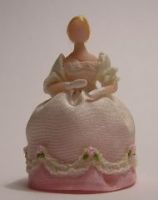
A girl going to a ball sometime in the mid-19th century. The swags on the skirt are cut from the edge of a scalloped lace. The flowers are snippets of bunka.
Mid-Victorian dress
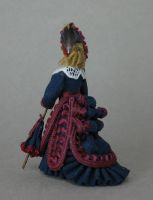
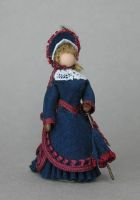
Beginning in the early 1870's, the crinoline cage was abandoned and the fullness of the skirt was instead pulled back and arranged in a bustle. For trim I used eyelash braid on the skirt, silk ribbon on the bodice, and unraveled bunka on the hat and umbrella.
Victorian servants
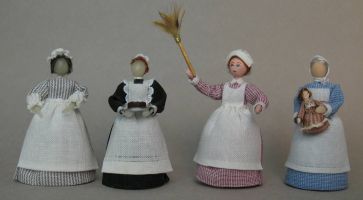
Cook, parlourmaid, housemaid and nanny, all based on patterns in Sue Atkinson's book Making & Dressing Dolls' House Dolls in 1/12 scale.
I cut the shoulder frill for the parlourmaid's apron from a piece of lace that had tiny scallops around the edge of every big scallop.
The nanny is holding a tiny doll by the late Frances Armstrong.
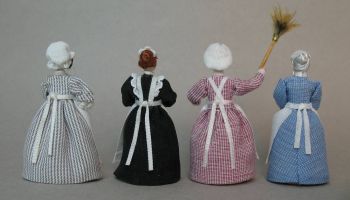
The servant dolls represent different stages in my dollmaking. The first two have Cernit bodies, but I didn't like Cernit as it's semi-transluscent which doesn't work very well with small parts like these. Notice how transluscent their hands are, and how the face is tinted by the hair shining through! Then I tried paperclay that I painted, but it was hard to shape around the wire armature and I spent forever mixing and matching paint for the skin. Besides, I decided I didn't care for faces with features. Finally, I settled for Fimo. I like the skin color straight from the package, and it's not transluscent.
Edwardian
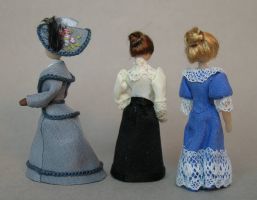
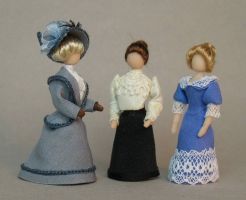
By the end of the 19th century, the fashion for tailored skirts and jackets began. There was also the Gibson Girl style - dark skirt and a light-colored high collar blouse with leg-o-mutton sleeves, and a big puffy hairdo.
The dress to the right was inspired by one I saw in Swedish director Ingmar Bergman's film Fanny and Alexander, which is set in the same era.
Dolls on my other pages
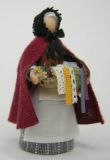
In some of my early houses and scenes there are dolls that don't appear on the separate dolls pages.
My peddler doll is now on the London street life page.
My Swedish dolls are on the Swedish costumes page.
